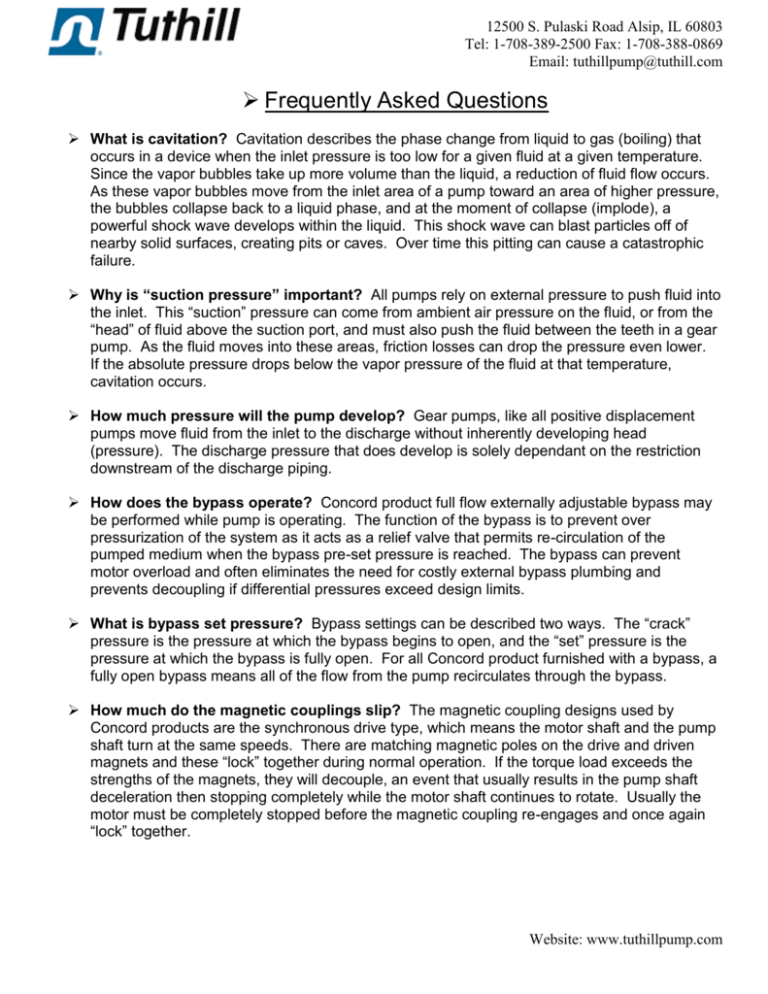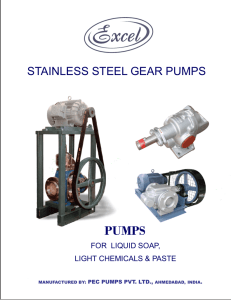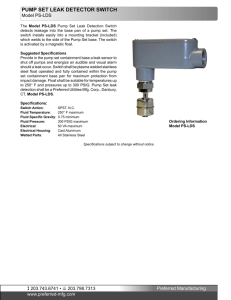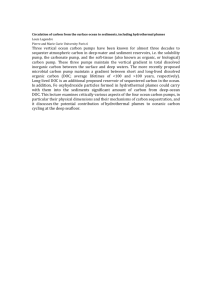Frequently Asked Questions
advertisement

12500 S. Pulaski Road Alsip, IL 60803 Tel: 1-708-389-2500 Fax: 1-708-388-0869 Email: tuthillpump@tuthill.com Frequently Asked Questions What is cavitation? Cavitation describes the phase change from liquid to gas (boiling) that occurs in a device when the inlet pressure is too low for a given fluid at a given temperature. Since the vapor bubbles take up more volume than the liquid, a reduction of fluid flow occurs. As these vapor bubbles move from the inlet area of a pump toward an area of higher pressure, the bubbles collapse back to a liquid phase, and at the moment of collapse (implode), a powerful shock wave develops within the liquid. This shock wave can blast particles off of nearby solid surfaces, creating pits or caves. Over time this pitting can cause a catastrophic failure. Why is “suction pressure” important? All pumps rely on external pressure to push fluid into the inlet. This “suction” pressure can come from ambient air pressure on the fluid, or from the “head” of fluid above the suction port, and must also push the fluid between the teeth in a gear pump. As the fluid moves into these areas, friction losses can drop the pressure even lower. If the absolute pressure drops below the vapor pressure of the fluid at that temperature, cavitation occurs. How much pressure will the pump develop? Gear pumps, like all positive displacement pumps move fluid from the inlet to the discharge without inherently developing head (pressure). The discharge pressure that does develop is solely dependant on the restriction downstream of the discharge piping. How does the bypass operate? Concord product full flow externally adjustable bypass may be performed while pump is operating. The function of the bypass is to prevent over pressurization of the system as it acts as a relief valve that permits re-circulation of the pumped medium when the bypass pre-set pressure is reached. The bypass can prevent motor overload and often eliminates the need for costly external bypass plumbing and prevents decoupling if differential pressures exceed design limits. What is bypass set pressure? Bypass settings can be described two ways. The “crack” pressure is the pressure at which the bypass begins to open, and the “set” pressure is the pressure at which the bypass is fully open. For all Concord product furnished with a bypass, a fully open bypass means all of the flow from the pump recirculates through the bypass. How much do the magnetic couplings slip? The magnetic coupling designs used by Concord products are the synchronous drive type, which means the motor shaft and the pump shaft turn at the same speeds. There are matching magnetic poles on the drive and driven magnets and these “lock” together during normal operation. If the torque load exceeds the strengths of the magnets, they will decouple, an event that usually results in the pump shaft deceleration then stopping completely while the motor shaft continues to rotate. Usually the motor must be completely stopped before the magnetic coupling re-engages and once again “lock” together. Website: www.tuthillpump.com 12500 S. Pulaski Road Alsip, IL 60803 Tel: 1-708-389-2500 Fax: 1-708-388-0869 Email: tuthillpump@tuthill.com What is vapor locking? Vapor locking is when a pump fills with enough vapor or gas to cause the pump to stop pumping. Vapor is a compressible fluid compared to incompressible fluids such as water. Some positive displacement pumps require pressure to function properly. For example, a diaphragm pump must build enough pressure and vacuum inside the diaphragm chamber to open and close check valves inside the pump. When the diaphragm chamber fills with too much vapor, the vapor is compressed and cannot build enough pressure to actuate the valves causing vapor locking. Why does the Tuthill Magnetically Coupled External Gear Pump resist vapor Locking? The Tuthill Magnetically Coupled External Gear pump contains no valves allowing vapors to flow through the pump. The Tuthill external Gear Pump also is very compact and has a very small pumping chamber that allows little room to collect vapors. The Tuthill External Gear pump is capable of pumping fluids with less than 0.3 centipoise viscosity. When the Tuthill External Gear Pump becomes partially filled with vapor or vapor enters the pump, the gears mix the vapor with the fluid resulting in a lower viscosity vapor liquid mixture. The pump will pump this mixture without vapor locking since it does not have to open any valve. Why should a Tuthill Magnetically Coupled External Gear pump NOT be oversized for metering? A Tuthill Magnetically Coupled External Gear Pump is designed to operate up to 4000 or 5000 RPM depending on the model and displacement. Reduced performance is an indication of a need for maintenance. Over sizing the pump may allow a worn pump to continue operate causing additional damage possibly resulting in leakage. If a large speed range turn down is not required, size the pump to operate toward the higher speed range. Example: preferred 2500 to 3500 RPM; not preferred 500 to 1500 RPM. What is cavitation? Cavitation describes the phase change from liquid to gas (boiling) that occurs in a device when the inlet pressure is too low for a given fluid at a given temperature. Since the vapor bubbles take up more volume than the liquid, a reduction of fluid flow occurs. As these vapor bubbles move from the inlet area of a pump toward an area of higher pressure, the bubbles collapse back to a liquid phase, and at the moment of collapse (implode), a powerful shock wave develops within the liquid. This shock wave can blast particles off of nearby solid surfaces, creating pits or caves. Over time this pitting can cause a catastrophic failure. Why is "suction pressure" important? All pumps rely on external pressure to push fluid into the inlet. This "suction" pressure can come from ambient air pressure on the fluid, or from the "head" of fluid above the suction port, and must also push the fluid between the teeth in a gear pump. As the fluid moves into these areas, friction losses can drop the pressure even lower. If the absolute pressure drops below the vapor pressure of the fluid at that temperature, cavitation occurs. How much pressure will the pump develop? Gear pumps, like all positive displacement pumps move fluid from the inlet to the discharge without inherently developing head (pressure). The discharge pressure that does develop is solely dependent on the restriction downstream of the discharge piping. Website: www.tuthillpump.com 12500 S. Pulaski Road Alsip, IL 60803 Tel: 1-708-389-2500 Fax: 1-708-388-0869 Email: tuthillpump@tuthill.com How much do the magnetic couplings slip? The magnetic coupling designs used by Concord products are the synchronous drive type, which means the motor shaft and the pump shaft turn at the same speeds. There are matching magnetic poles on the drive and driven magnets and these "lock" together during normal operation. If the torque load exceeds the strengths of the magnets, they will decouple, an event that usually results in the pump shaft deceleration then stopping completely while the motor shaft continues to rotate. Usually the motor must be completely stopped before the magnetic coupling re-engages and once again "lock" together. Can I use a Tuthill external gear pump with viscosities above 2000 cps? Tuthill pumps operate very well above 2000 cps viscosity. Essentially, if the fluid can flow into the pump, a Tuthill pump can be made to pump it. The Tuthill external gear pumps are manufactured with high precision and the internal clearances are normally very small to provide very little flow loss when pumping low viscosity fluids at pressures up to 250 psi (17 bar). High viscosity applications require the internal clearances to be adjusted to match the viscosity of the fluid. This reduces the power required to drive the pump and raises the decoupling pressure limit. To determine if a Tuthill pump can be used in your high viscosity application, complete an Inquiry Work Sheet including the fluid viscosity and send to Tuthill Pump Group, Concord Operations. Can I use a Tuthill external gear pump above its maximum differential pressure rating? The pressure limit for each Tuthill pump is established with water as the fluid, which has no real lubricating properties and has a relatively low viscosity. The bearing load, flow characteristic, or the magnet decoupling torque then determines the pressure limit. A pump cannot operate above the magnet decoupling torque. However, the bearing load limits and flow characteristics change with higher viscosity lubricating fluids, which provide more lubrication and reduce slip. To determine if a Tuthill pump can be used in your high pressure application, complete an Inquiry Work Sheet including differential pressure and send to Tuthill Pump Group, Concord Operations. What is a positive displacement pump? A positive displacement pump has a constant volumetric displacement such as gallons per revolution or milliliters per revolution. A centrifugal and turbine pump uses the centrifugal force to propel the fluid causing movement. Examples of positive displacement pumps include peristaltic, vane, piston, and gear pumps. A positive displacement pump is usually more efficient resulting in less driving power and less heat transferred into the fluid. A positive displacement pump has very little fluid slip allowing pumping at high differential pressures with very little flow loss. As with many positive displacement pumps, the Tuthill external gear pumps are self priming. Why are positive displacement pumps self-priming and centrifugal pumps are not? A centrifugal pump uses the centrifugal force to propel the fluid causing movement. The centrifugal force depends on the fluid mass to cause fluid motion and build pressure. Because air has virtually no mass, a centrifugal pump cannot build a vacuum to prime unless it is full of liquid. A positive displacement pump, such as a Tuthill external gear pump, has a set volumetric displacement. This allows the gear pump to pump at very low viscosities, even air, which ultimately builds a vacuum that draws fluid into the pump. Website: www.tuthillpump.com 12500 S. Pulaski Road Alsip, IL 60803 Tel: 1-708-389-2500 Fax: 1-708-388-0869 Email: tuthillpump@tuthill.com Can a Tuthill Magnetically Coupled External Gear Pump be used for metering? Tuthill external gear pumps are precision positive displacement pumps. They produce very accurate and repeatable constant flow under constant pressure and speed. They also produce very accurate predictable flow under variable pressure and speed. The accuracy is proportional to the accuracy of the driving device. A driving device with accuracy better than +/- 0.25%, such as the Tuthill Digital Variable Flow Drives, will produce essentially the same +/- 0.25% accuracy with a Tuthill pump. Also, a Tuthill external gear pump maintains constant flow performance over thousands of hours maintaining long-term accuracy. Tuthill external gear pumps are ideal for metering and often have much lower cost with greater accuracy and more features compared to typical metering pumps. What is the difference between NPSH and NPIP? NPSH is Net Positive Suction Head and NPIP is Net Positive Inlet Pressure. They are the same thing except NPSH is measured in head such as feet or meters and NPIP is measured in pressure such as psi or bar. NPIP was originated for positive displacement pumps. When converted to the same units, NPSH and NPIP are the same values. Why are Tuthill Magnetically Coupled External Gear Pumps compact in size? Tuthill external gear pumps are compact, ranging from 1.6 inch diameter to 3 inch diameter and lengths from 1 to 3 inches excluding magnetic coupling and motor. The compact size is a result of the internal gear design allowing higher rotational speed without sacrificing performance or life. The high rotational speed displaces more fluid in a small package size. The design results in low fluid velocities providing good NPSHR values. The high rotational speeds also require less torque reducing the magnetic coupling size. What kind of life can be expected from a Tuthill external gear pump? Tuthill magnetically coupled 316 stainless steel external gear pumps can be expected to operate over 20,000 hours in good applications. The Tuthill P-series, constructed with an engineered polymer, can be expected to last over 10,000 hours in many applications. The long life is the result of the absence of dynamic seals, low bearing loads, and no sliding surfaces. How can a pump operating at 2 pole speed have longer life than slower speed pumps? Most pumps operate at much slower speeds than a 3500 RPM 2 pole motor. Tuthill external gear pumps are designed to operate up to 4,000 or 5,000 RPM, depending on the model. Life is proportional to bearing load and linear distance of rotation. Tuthill external gear pumps are designed with compact gears that generate low bearing loads and low linear distance of rotation. Linear distance of rotation is the total distance an object, such as a car tire, will travel when rolled on a flat surface. As an example, a two-inch diameter gear operating at 1750 RPM for 10,000 hours will result in the same linear distance of rotation as a one-inch diameter gear operating at 3500 RPM for 10,000 hours, a total of 5.5 X108 feet. What is the difference between rotational speed (such as RPM) and fluid velocity? Pumps are rated by the rotational speed in RPM, however, the fluid velocities are the combination of rotational speed and the outer fluid diameter. A pump operating with lower fluid velocity will generally have improved life, lower NPSHR (inlet losses), higher efficiency, and lower noise. A pump operating at 1200 RPM with a 6 inch diameter will have a 26.2 ft/second fluid velocity and a 1 inch diameter operating at 5000 RPM will have a 21.8 ft/second fluid velocity. Website: www.tuthillpump.com 12500 S. Pulaski Road Alsip, IL 60803 Tel: 1-708-389-2500 Fax: 1-708-388-0869 Email: tuthillpump@tuthill.com Why is fluid velocity important? Pumps with higher efficiency and lower NPSHR provide better overall performance. Too much pressure loss at the inlet will cause cavitation or boiling of the fluid. As a basic rule, the pressure loss is proportional to the square of the fluid velocity. Higher fluid velocities in any pumping chamber cause increased pressure loss reducing pump efficiency increasing heat transferred to the fluid and requiring more driving power. An example is a 6 inch diameter pumping chamber at 1000 RPM will have 1.7 times the pressure loss as a 1 inch diameter at 5000 RPM. Can I pump thin fluids with a Tuthill external gear pump? Tuthill magnetically coupled rotary external gear pumps perform well with thin fluids. As a general rule, pump performance is fine down to 0.3 cps viscosity, however, they are also applied on thinner fluids. Low viscosity fluids can be difficult for many types of pumps as a result of slip and wear. Slip is the fluid that flows (slips) from the discharge side of the pump back to the inlet. The Tuthill gear pump design minimizes slip and wear. They are constructed with a minimal number of high precision parts providing less internal slip paths. Tuthill pumps are designed to operate at two-pole motor speed, 3500 RPM, reducing the slip to displacement ratio. The Tuthill external gear pump design minimizes gear and bearing loads allowing the pumps to operate on fluids with minimal lubrication. To determine if a Tuthill pump can be used in your low viscosity application, complete an Inquiry Work Sheet including the fluid viscosity and send to Tuthill Pump Group, Concord Operations. Website: www.tuthillpump.com







